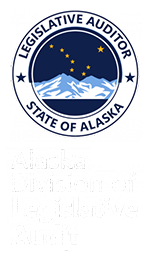| SUMMARY OF: | A Special Review of the Department of Health and Social Services, Medicaid and Children’s Health Insurance Program Eligibility |
Why DLA Performed This Audit
The audit was requested in recognition of the State’s declining fiscal condition and the high amount of State general funds spent on Medicaid and Children’s Health Insurance Program (CHIP) benefits. Audit objectives included determining whether Department of Health and Social Services staff properly determined eligibility and timely enrolled beneficiaries, terminated benefit coverage for individuals no longer eligible for benefits, and preserved and maximized the use of Medicaid and CHIP funds. Auditors were directed to estimate the amount that the State of Alaska paid for benefits on behalf of ineligible beneficiaries and to review the extent eligibility determination best practices were implemented.
Report Conclusions
The audit found that 42 percent of Division of Public Assistance (DPA) eligibility determinations tested were not accurate and 43 percent were not made in a timely manner. Many of the errors were procedural in nature with no fiscal impact, while some errors resulted in ineligible costs. Based on the testing results, the audit estimates $102 million of federal funds and $28 million of State general funds were spent on FY 19 benefits for ineligible recipients. The estimate is likely understated because DPA has no procedures for verifying household size, a critical component of eligibility, and auditors were unable to test the accuracy of household size.
The widespread errors were attributed to inadequate staffing and training. According to management, Medicaid expansion and an economic recession created a large backlog of applications. During this time, processing applications was prioritized over quality control activities, such as supervisory reviews and training. As a result, the accuracy and timeliness of eligibility determinations declined.
A new eligibility system implemented in 2014 to meet requirements of the Affordable Care Act (ACA) further contributed to eligibility errors. Rather than streamlining the eligibility process as envisioned by the ACA, the system was plagued with problems that created inefficiencies. At the time of the audit, the system continued to have material control weaknesses.
The audit identified several system-related “best practices” that may reduce workload, streamline the application process, and improve accuracy. Implementing the best practices will require information technology expertise and adequate funding.
Findings and Recommendations
- DPA’s director should improve Medicaid and CHIP eligibility training and reestablish a case review process.
- DPA’s director should continue to resolve system weaknesses in Alaska’s Resource for Integrated Eligibility Services System.
- DPA’s director should update Medicaid and CHIP regulations for modified adjusted gross income eligibility requirements.

